

| WARNING Coolant can be extremely hot and cause severe burns, is toxic and very slippery. Do not remove the radiator cap or attempt to change the coolant when the engine is hot; allow it cool completely. Immediately wipe any spilled coolant from tires, frame, engine or other painted parts. Do not ingest coolant. |
Remove the radiator cap in two steps. First turn the cap counterclockwise to the first stop. Then push and turn it further in the same direction and remove the cap.
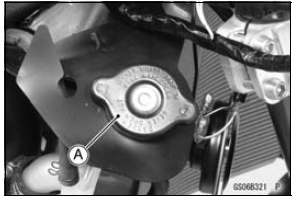
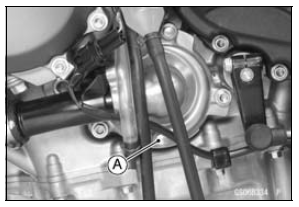
Torque - Coolant Drain Bolt (Water Pump): 9.8 N·m (1.0 kgf·m, 87 in·lb)
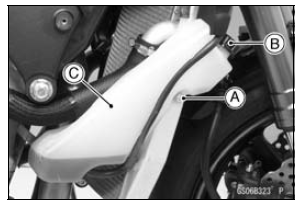
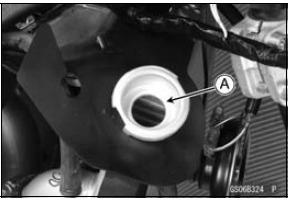
NOTE
Pour in the coolant slowly so that it can expel the air from the engine and radiator.
NOTICE
Soft or distilled water must be used with the antifreeze (see below for antifreeze) in the cooling system.
If hard water is used in the system, it causes scales accumulation in the water passages, and considerably reduces the efficiency of the cooling system.
Water and Coolant Mixture Ratio (Recommended)
Soft Water: 50%
Coolant: 50%
Freezing Point: –35°C (–31°F)
Total Amount: 2.6 L (2.7 US qt)
NOTE
Choose a suitable mixture ratio by referring to the coolant manufacturer’s directions.
Start the engine with the radiator cap removed and run it until no more air bubbles [A] can be seen in the coolant.
Tap the radiator hoses to force any air bubbles caught inside.
Stop the engine and add coolant up to the radiator filler neck.
If the coolant level is lower than the “L” level line, add coolant to the “F” level line (see Coolant Level Inspection).
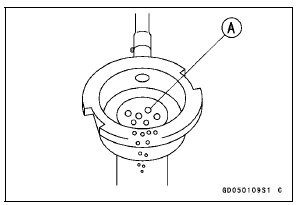
NOTICE
Do not add more coolant above the “F” level line.
 Fuel Hose Replacement
Fuel Hose Replacement Radiator Hose and O-ring Replacement
Radiator Hose and O-ring ReplacementClutch Cover Installation
Using a cleaning fluid, clean off any oil or dirt that may
be on the silicone sealant coating area. Dry them with a
clean cloth.
Apply silicone sealant to the area [A] where the mating
surface of the crankcase touches the clutch cover gasket.
Sealant - Liquid Gasket, TB1211F: 92104-000 ...
Air Intake Solenoid Valve (Service Code 2d, Equipped Models)
Air Intake Solenoid Valve Removal/Installation
Refer to the Air Intake Solenoid Valve Removal/Installation
in the Fuel System (DFI) chapter.
Air Intake Solenoid Valve Inspection
Refer to the Air Intake Solenoid Valve Unit Test in the
Electrical System chapter.
If the air intake ...
Inquiries to Rider
DFI Diagnosis Flow Chart
Each rider reacts to problems in different ways, so it is important to
confirm what kind of symptoms
the rider has encountered.
Try to find out exactly what problem occurred under exactly what
conditions by asking the rider;
knowing this information may h ...